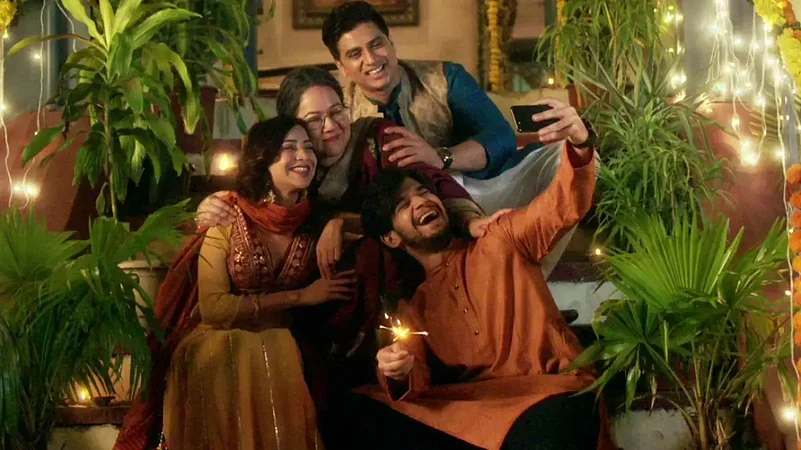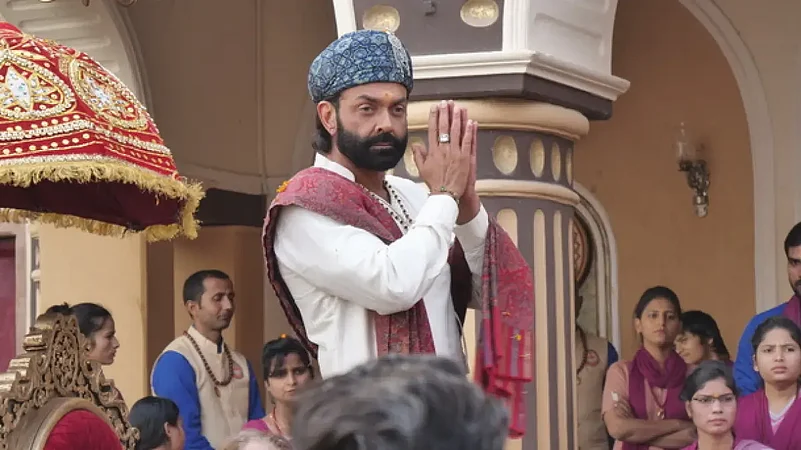Indian OTT content has been booming. Every week there are numerous OTT shows and films coming up and as per reports, audiences seem to be lapping them up as well. A few years back, when OTT was just starting out in India, it felt like something that was for the urban masses with stories from the urban cities being watched by people on their smartphones having unlimited mobile data. However, things have changed in the last three-four years.
Stories on OTT seem to be migrating towards smaller towns and rural areas. Shows like ‘Jamtara’ on Netflix, ‘Panchayat’ on Amazon Prime Video, ‘Sutliyan’ on Zee5 or ‘Aashram’ on MX Player have all tried to show stories from the rural heartlands of India. Such shows and films are not just getting viewership from the rural or small town pockets, but even the urban populace has started enjoying these stories from the heartlands like ‘Minnal Murali’ or ‘Paatal Lok’ or ‘Kaagaz’.
So, what has brought about this change? Outlook talks to some of the biggest players in India’s OTT scene like Netflix, MX Player, Zee5, Lionsgate Play, Aha, etc.
Stories From The Heartlands Offer Unique Perspectives
Speaking to Outlook, Netflix India's spokesperson says, "Today with streaming services like Netflix, a unique story with novel treatment has the ability to find its audience without limitations on format, language or duration. India has diverse and authentic stories in abundance waiting to be discovered and shared with the world. And for us, it's really about bringing these stories to life in the most authentic way possible from all corners of the country, reflecting as many lives on screen as possible. Whether it's the critically acclaimed Marathi film ‘The Disciple’ or a superhero film ‘Minnal Murali’ set in Kerala, which trended in the Top 10 across 30 countries, or our recent series ‘Mai’ and ‘Yeh Kaali Kaali Ankhein’ set in UP, our aim has been to bring in the most entertaining stories to our viewers which also have a deeper meaning within.”

“Stories set in the heartlands have resonated really well with our audience mostly because they offer differentiated and unique perspectives into characters' lives which are similar to ours and yet so different. This is precisely why we are constantly investing in both original and licensed content from around the country. Our members have discovered and enjoyed watching titles set in the heart of India, such as our crime thriller ‘Aranyak’, ‘Jamtara’, ‘Kota Factory’, the Tamil film ‘Jagame Thandiram’ and more," Netflix spokesperson adds.
There Is No One-Size-Fits-All Strategy
Manish Kalra, Chief Business Officer, Zee5 India says, “As a content provider to millions of entertainment seekers, our focus has always been on how compelling a story is and the art of storytelling as there is no one-size-fits-all strategy when it comes to content. OTT has essentially expanded the entertainment canvas for consumers enabling them to explore a wider range of genres at a lower cost than the alternate mediums. This has insinuated a shift in consumption patterns and audience preferences; with more options available to customers, quality now takes precedence over all other factors. It is essential to stay authentic and engaged while one takes the risks in exploring new plots and genres.”

“On ZEE5, we have received a positive response for this genre with the success of ‘Kaagaz’, ‘Rangbaaz’, ‘Rashmi Rocket’, ‘Sutliyan’ etc. and we have more lined up in the content funnel. It has always been our mission at ZEE5 to curate a diverse slate of content and achieve inclusivity in the creative ecosystem. The popularity of stories from the heartland has resulted in greater possibilities and better utilisation of talent, resulting in stories that are real, resonant and appeal to our audiences,” Kalra adds.
More Accurate Understanding Of Contemporary India
Talking about stories from small towns and rural areas, Mrinalini Khanna, VP, Originals, Lionsgate India says, “I think it’s a great trend. While it may have started with the intention to connect with a higher volume of the audience – it’s managed to showcase a more accurate understanding of contemporary India which is wonderful. At Lionsgate Play – our aim is to give life to as many versions of diversity that co-exist within India, with the intention of getting audiences to relate, empathise and appreciate varying characters."
"Of course – we are also keen to bring that lens to Urban India so that there’s an exciting, entertaining and very unique set of stories on the platform,” Khanna adds.
Everyone Is Moving Towards Small-Towns And Rural Areas
Gautam Talwar, MX Media, Chief Content Officer, reiterated, “This has been true for us for a long time though other OTTs may be moving to it now. The logic is that our distribution and reach are huge in Tier 1 and Tier 2 rural areas and therefore the shows that we make are catering to those audiences. Not only are the locals based there but the story and relatability of the audience itself are from the small town. We consciously and actively look for stories that belong to a small town in India whether it has been ‘Indori Ishq’, ‘Mastikand’, ‘Ratkanchal’ or a ‘Begum’. ‘Ratkanchal’ is hard core Uttar Pradesh. ‘Indori’ is Indore, ‘Mastikand’ is again small-town India, Meerut, and 'Campus Diary' is shot on an actual location in a University in Chandigarh.”

“Today, everyone is moving towards small towns and rural areas. In that sense, we have been ahead of this curve for a very long period of time and if you have to create stories for them, it has to be relatable to them and come from their cultural belief. That is why we make sure that the story is always set in that area,” Talwar adds.
Not Just Stories Of Violence
While OTT players have been harping on the violence in smaller towns and rural areas, there seems to be an acceptance of family dramas as well in recent years. Speaking on the same Talwar adds, “Another sentiment that’s playing well on I don't think it’s about rural stories being violent or not. Look at the story of ‘Aashram’ which is also based on the town of Kashipur which is a small town in India. It is not a violent story necessarily. It is crime but it's not violent. I don't think that rural stories are either family drama or more violent. I think rural stories are more relatable where we can actually represent their culture in the right manner.”
OTTs Explore Full Diversity Of Audiences Across India
On the same topic, Ajit Andhare, COO, Viacom18 Studios, which owns a for-OTT content brand Tipping Point, said, “Tipping Point translates our film-scale mindset to OTT platforms with unconventional narratives. Just like in our films good stories can come from anywhere. We don't necessarily see content as urban or heartland. A story naturally belongs to a setting, it must stay true to it. Many of our successes like ‘Jamtara’ or ‘Taj Mahal 1989’ were set in smaller cities. However, the ‘She’ franchise is based in Mumbai while ‘Ray’ was based in both metros and smaller cities.”

“OTTs give you the opportunity to explore the full diversity of audiences across India freeing you from these traditional labels. As long as you are connecting to a large enough viewing cohort, you could be setting it really anywhere. Look at ‘Guilty Minds’, it is set in a law firm but travels down to small towns/villages as needed by the story," Andhare adds.
There Is A Need For Such Stories
Weighing in on the topic, Ajit Thakur, CEO, Aha, says, "Entertainment had always been at its best, when its rooted in local culture and local language. When we launched aha with the promise of local stories from their land, large audience connected with it, people associated with it as “our app” because of its local promise. Most of us are from small towns with some roots in rural, so there is a need for those stories, which OTT is able to fill in, and it can be accessed by anyone anywhere. This is also evident in the love for local and regional content on OTT irrespective of where you are staying."
When You Go International, It’s All About Being Indian
Nivedita Basu, Head Of Content Strategy And Business Alliances, Atrangii says, “With the internet becoming free and players like Jio making it accessible to people in rural parts of India, which is the majority of the population, it’s only fair that the Indian OTT shows are catering to the rural audiences. And when you go international, it’s all about being Indian. You cannot have a modern show which has already been done in other countries and replicated in India. That’s why people have a disconnect with those kinds of shows."

"What’s good about OTT is that it’s at the touch of your palm, and you can watch what you want. But yes, the appeal from shows like ‘Paatal Lok’ and ‘Jamtara’ and ‘Mirzapur’ and others it’s bent more towards the rural pockets and therefore the better connect with the masses," Basu adds.
Is This Trend Of Stories From The Heartland Going To Stay?
Basu says, "Even now when we are doing stories on Atrangii, our stories are a lot from the Hindi heartland. The reason is OTT is not just restricted to just India and its tier one and tier two pockets. OTT is across the world. For these international audiences, they’ve seen the modern cities, and the cultures in these cities are also pretty much the same as any other big cities, and we are anyways aping the west in the urban side of our country. But the rural parts of the country are something that’s very local to that place. For example, what I’m seeing in a story from Haryana or Kerala or any of the southern releases, intrigues me more. The south stories of Malayalam, Telugu, Tamil etc have become par excellence. So, I think the bent is going to be there (rural and small towns) for a long time,” concludes Basu.

















